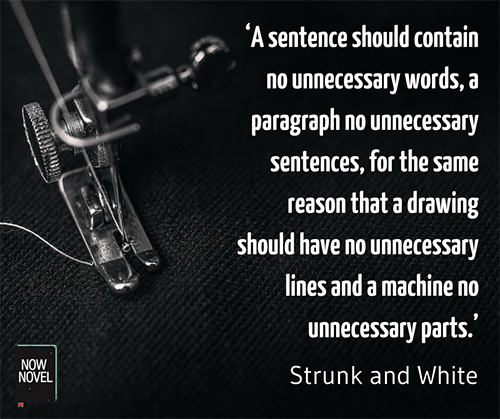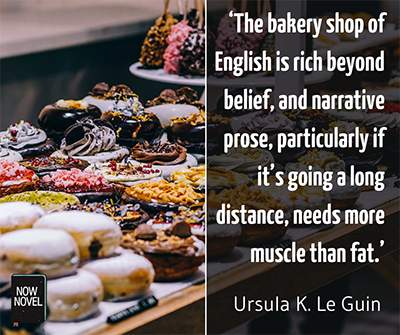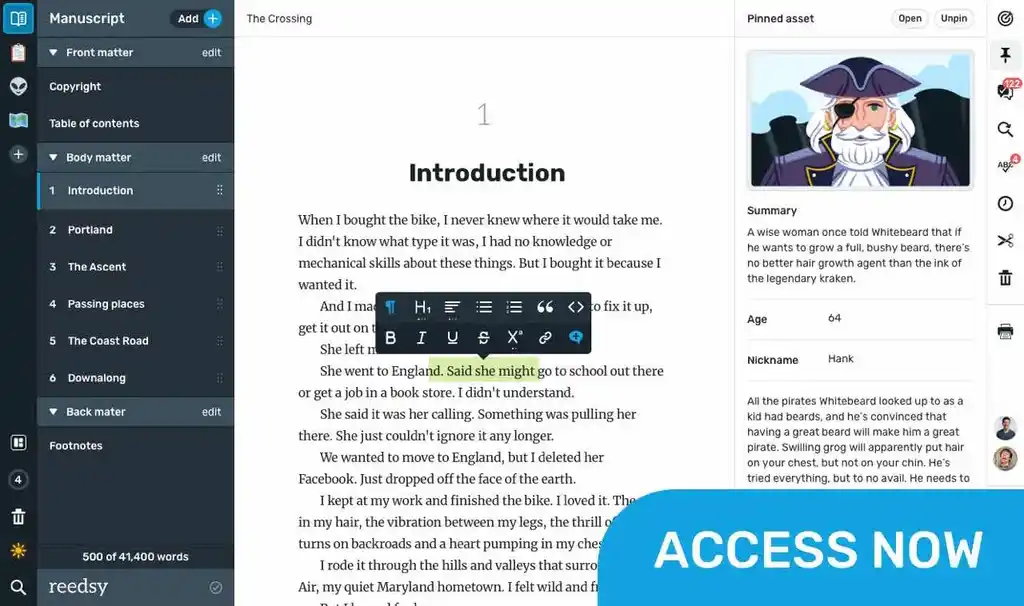Developing the story content of your writing – your characters, plots, dialogue and other areas – is important. Yet mastering different writing styles is equally important if you want to convey your story to readers with creative precision. Read 10 tips for developing and mastering your language use:
First: What is style in writing?
Style, as a broad term, refers to ‘a way of painting, writing, composing, building, etc/. characteristic of a particular period, place, person, or movement.’ (Oxford English Dictionary). The parallels to painting, writing a piece of music or designing a building are useful. Like each of these other media, great writing, a great story or sentence, has structure.
Put together a building without some thought to design, and who’ll want to live in it? Forget to add the right supports and the roof could cave in. Strong style in writing invites readers to live in your world. It holds the roof of your story up.
What makes each author’s style different? Sentence length and structure, vocabulary, mood and tone. One author might use simile and metaphor a lot. (Arundhati Roy has this kind of style.) Another might use little comparison, preferring stark, spartan imagery. These are elements of style.
So how do you master different ways of writing and develop a writing style that is completely your own?
1: Get a good writing style guide
This post goes into some detail, but it’s worth getting a print style guide that you can dip into often, one that covers the rules of grammar and punctuation comprehensively, as well as stylistic devices you can use to vary your prose.
Two classic style guides are Strunk and White’s The Elements of Style (a long-standing prescribed text for many writing courses in the US) and The Oxford Essential Guide to Writing by Thomas S. Kane. Although Strunk and White’s guide has been criticized for shortcomings (one reader on Goodreads singles out the antique advice to write ‘persons’ rather than ‘people’), there is still plenty of good advice on improving style. For example:
‘Vigorous writing is concise. A sentence should contain no unnecessary words, a paragraph no unnecessary sentences, for the same reason that a drawing should have no unnecessary lines and a machine no unnecessary parts.’
Kane’s Oxford guide goes into minute detail. For example, there is a whole chapter on different sentence styles. He uses the following example by Joan Didion to illustrate the ‘periodic sentence’. This is a sentence where the main clause is put near the end rather than the beginning. As Kane writes ‘delaying the principle thought [in a sentence] increases its importance’. It gives it extra weight:
‘Paralyzed by the neurotic lassitude engendered by meeting one's past at every turn, around every corner, inside every cupboard, I go aimlessly from room to room.’
If you don’t want a print guide, try writing style guides on universities’ English department pages. For example, the Yale writing centre offers concise, helpful grammar tutorials you can download here.

2: Copy out favourite paragraphs by authors you love
Many great artists have learned by copying the masters. Famous painters learn by reproducing masterworks; Bach learned composition in part by copying out the works of his predecessors.
You don’t have to copy out the whole of Pride and Prejudice. When you come across a sentence or paragraph you love, write it down in a book for insight and inspiration. Take a moment to analyse how it’s put together; why it works. Keeping a reading journal like this will benefit your style over time. You’ll lift the veil of what distinguishes the writing styles of favourite authors; what makes them effective.
3: Play with how you structure sentences and avoid mistakes
Whether you’re writing Regency romance in a verbose (wordy) style, or you’re writing stark prose like Hemingway, knowing sentence structure inside out will improve your style.
Bad grammar and punctuation are style killers. Here are some things to avoid:
Dangling participles
For example, in ‘Running down the stairs, her dress hooked on a nail and tore’, it seems a character’s dress (independently of her) is doing the running. We can guess the subject of the sentence is the ‘her’ but the placement of the object ‘her dress’ in the subject position makes the dress the deed-doer. Better: ‘As she ran down the stairs, her dress hooked on a nail and tore. Here, ‘she’ is the subject.
Weird changes of tense
If your character is doing something now and suddenly we’re in the past, mid-sentence, with no contextualization, this is naturally confusing and bad style. For example: ‘I open the door and quickly slam it shut. He was still standing outside so I ran to the phone.’ The sentence shifts unexpectedly into the past tense, making it hard to tell what is happening when. Read tips on making sense of tense here.
Monotonous repetition
Repeating a word to much deadens writing. Although you might use repetition for effect (such as in Dickens’ famous opening, ‘It was the best of times, it was the worst of times’), this type of repetition is usually carefully arranged and structured for emphasis and effect.
Here, for example, repetition of the word ‘door’ makes the author’s hand too visible:
‘I ran to the door. The door was locked and I wasn’t expecting visitors, but I heard three knocks again. I stood behind the door, unsure whether I should open it. There they came again, more urgent.’
Better style would use a mix of nouns and pronouns, and different sentence structure, to avoid needless repetition. For example:
‘I ran to the door. It was still locked – I wasn’t expecting visitors. Three knocks thudded again. I froze, hesitant to open. More knocking, now urgent.’
Practice writing sentences where the main clause (the main subject and verb of the sentence) comes near the start versus near the end. Practice taking clumsy sentences and rewriting them for flow and concision. These exercises will help you improve your writing style.
4: Learn about style by giving and receiving writing feedback
The best books on writing style give you the theory, but giving and receiving writing feedback give you the practice.
The benefit of receiving critiques on your writing is that other aspiring or established authors may notice and comment on quirks and issues in your writing style you weren’t conscious of before.
The benefit of giving critiques is you learn how to pinpoint what isn’t working in others’ sentences and paragraphs. In the process, you become aware of how to avoid turgid style yourself.
[To give and receive constructive feedback, join Now Novel’s friendly critique community].
Comparing different authors' writing styles also gives useful insights:
5: Compare authors’ writing styles
Examining the quirks of different authors’ writing styles, their language choices, is often instructive.
In Ben Blatt’s fascinating book using statistics to explore the quirks of famous authors, Nabokov’s Favourite Word is Mauve, there are many insights into how authors’ styles differ. For example, James Patterson, whose thrillers are packed with common tropes, uses the most clichés of all authors Blatt surveys. Across his Alex Cross series, Patterson uses on average 160 cliches per 100,000 words. At the opposite end of the spectrum, Khaled Hosseini, author of The Kite Runner, uses just 71 per 100, 000 – less than half. Yet Hosseini is a more ‘literary’ author so this difference makes sense.
Blatt also ran other interesting experiments. For example, he found the three words that different authors use in at least half their books, at least once per 100, 000 words. This gave Blatt an approximation of authors’ favourite words.
David Baldacci, writing thrillers in contemporary settings, had the favourite words ‘web’, ‘laptop’, and ‘limo’. Compare with mystery author Agatha Christie’s ‘favourite’ words across 66 of her novels: ‘inquest’, ‘alibi’ and ‘frightful’. They’re related to her genre, as well as her nationality (‘frightful’ being a distinctly British adjective).
Thinking about what makes authors’ individual styles unique, from national quirks to genre-specific crutches, is useful. It illuminates how different the creative choices we make are, as well as the great wealth of different ways you can tell a story.
6: Edit for style after you draft
As authors, we often edit for plot and character holes, for typos and errors. Make a conscious decision to improve style, too, wherever possible. Clunky repetition? Cut it out. Dead simile or metaphor (e.g. ‘poor as church mice’)? Invent your own alternative that makes a fresher, less abused comparison.
Improving your writing style begins with paying attention to the words, expressions, phrases and sentence structures you choose.
7: Try writing styles that you wouldn't usually use
There’s a reason art students often learn multiple media. For one, you learn control. Secondly, you gain versatility. Charcoal life-drawing; papier-mâché, watercolours. Trying different approaches broadens your horizons, expands your palette.
The same goes for writing style. If you usually write long, complex sentences, try writing a chapter where no sentence is longer than 8 words. Forcing yourself out of habitual writing style is a great way to unearth other possibilities. There’s creativity in trying new constraints.
8: Vary your writing style to suit subject, tone and mood
It wouldn’t make sense to discuss writing style without talking about tone and mood. The tone and mood of a scene in a story affects writing style. In a tense, dramatic scene, in rising action (a shootout, a chase), it makes sense for many sentences to be short and action-oriented. This increases the pace.
For example, here David Mitchell describes the reporter Luisa Rey in his Booker-shortlisted novel Cloud Atlas. Luisa is investigating a dodgy environmental cover up:
‘A more alert quarter of Luisa’s brain muscles in. Isaac Sachs left the Sixsmith Report in your VW. You mentioned the hood didn’t lock. He assumes this hotel is not safe and that we are being eavesdropped.’ (p. 140)
The brief, stepwise thoughts of the character mimic a person scanning their memory for details, and the style (including writing private thoughts in italics) shows the anxiety and tension of this whistleblower’s situation.
9: Use precise and selective adverbs and adjectives
Many writers have shunned adverbs. In his book On Writing: A Memoir of the Craft, King writes:
‘I believe the road to hell is paved with adverbs, and I will shout it from the rooftops. To put it another way, they're like dandelions. If you have one on your lawn, it looks pretty and unique. If you fail to root it out, however, you find five the next day... fifty the day after that... and then, my brothers and sisters, your lawn is totally, completely, and profligately covered with dandelions.’
Even so, King himself uses 105 adverbs ending in ‘-ly’ per 10, 000 words across 51 of his novels, according to Blatt in Nabokov’s Favourite Word is Mauve. The trick with using fewer adverbs is to use them effectively.
In the sentence ‘she ran quickly to the door’, ‘quickly’ is ineffective because the verb ‘ran’ could do the work of this word instead. If we write ‘she sprinted to the door’ or ‘she rushed to the door’, the sentence is saying ‘this is the character’s mental state’ (hurry) rather than ‘this is how the character’s running looks.’ We’re showing what matters, succinctly.
This is the stellar advice Ursula K. Le Guin gives on writing style and using adverbs and adjectives, in her writing guide Steering the Craft:
‘I would recommend to all storytellers a watchful attitude and a thoughtful, careful choice of adjectives and adverbs, because the bakery shop of English is rich beyond belief, and narrative prose, particularly if it’s going a long distance, needs more muscle than fat.’ (p. 62)

10: Develop a style appropriate to your audience
Audience is an important element to consider regarding writing style. A YA audience won’t have as extensive vocabularies as seasoned, older readers. If writing a YA novel, your revision process should include pinpointing excessively difficult words and finding simpler solutions that keep your story’s reading level age-appropriate. For example, you could easily replace a word like ‘octogenarian’ with ‘senior’.
Ready to improve your craft? Join Now Novel now for helpful feedback and brainstorm ideas for your story.










delicious tips,you've written it all so well. :) I have learned a lot and I'm keen to improve my writing skills
Nicoli Redmayne - Over 8 years ago
Thanks so much, Nicoli. Thank you for reading. Glad to hear you're motivated.
Bridget At Now Novel - Over 8 years ago
Well written, thanx for enlightenment,Certainly helpful for ameture like me Waiting for next treat ..I am subscribing it now
Imran Ahmed - Over 8 years ago
Thanks, Imran! Thank you for reading.
Bridget At Now Novel - Over 8 years ago
"Repeating a word to much deadens writing." Hm, and I wonder where, upon this globe, Much is? ;) That aside, I've been searching for an article like this for to show my friends! It entices me to peruse this blog a little more to see if I can find more gold nuggets. A pity I'm not American; I won't be using those writing style guides mentioned. I'll have to ask Google if it knows a British one. Anyhow, thank you for sharing. Cheers!
Lord Potato - Over 7 years ago